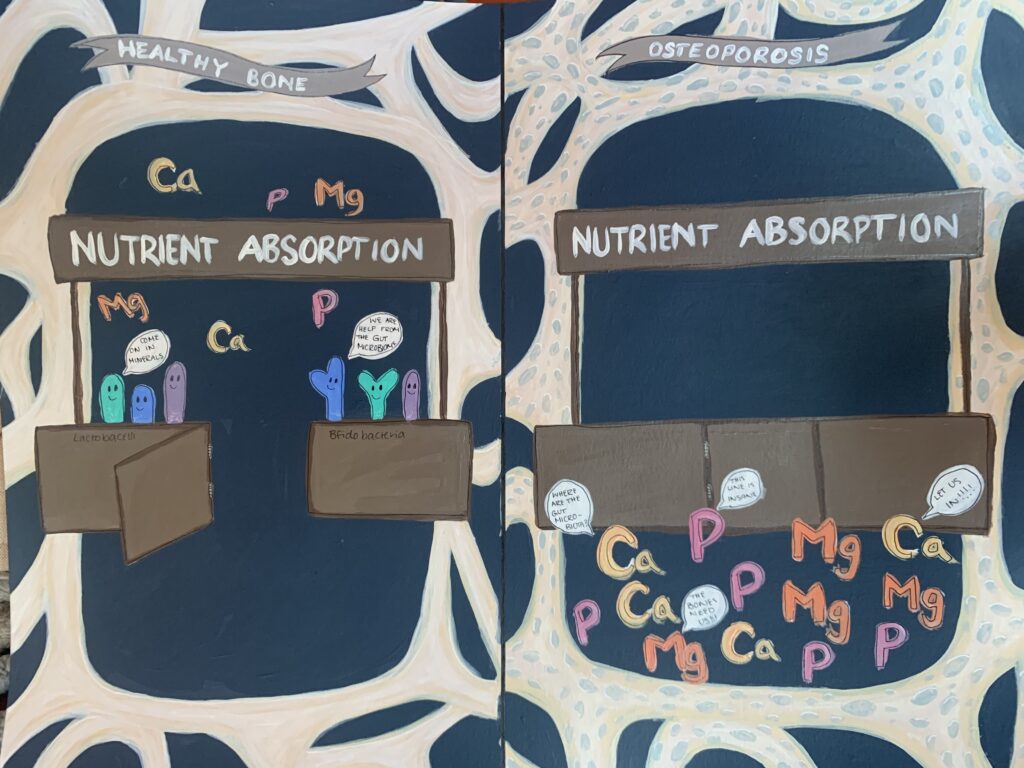
Effects of the Gut Microbiota on Osteoporosis
By: Katarina Jordan
For this project, I decided to research more about osteoporosis and specifically if there is a link between osteoporosis and the gut microbiome. Our bodies have many systems that communicate with each other so I was very intrigued to read about this topic. This project is connected to the class objective “Know the stages of bone development and repair” because osteoporosis is a disease caused by a dysfunction in the proportions of activity between osteoclasts versus osteoblasts.
Osteoporosis is a bone disease that is common in many people as they age, specifically women. This disease leads to a significant loss of bone density leading to brittle bones that are prone to breakage. Osteoporosis is largely affected by hormones, especially the loss of estrogen that women endure during and after menopause, but there are other factors that can affect the likelihood of osteoporosis, or the rate at which it progresses. These outside influential factors include exercise, diet, and even the gut microbiome.
One of the most prominent linkages between the gut microbiome and osteoporosis that I found was involving nutrient absorption. There are many commensalistic bacteria living in the gut that when in sufficient numbers aid in the absorption of minerals into the endothelial cells that make up the gut lining. Those minerals can then be used in different processes within the body such as bone mineralization. There was a study that showed that the prominence of different species of lactobacilli and bifidobacteria in the gut were specifically useful in the absorption of calcium, phosphorus, and magnesium (Ding et al., 2020). The absorption of these minerals is crucial in maintaining a healthy bone density because bone is made primarily of hydroxyapatite which contains high levels of calcium and phosphorus (Vannucci et al., 2018), along with a small level of magnesium. With a better ability to absorb these minerals, you would have a higher bone density, which would lead to a lower risk of developing osteoporosis(Zhou et al.,). Or if osteoporosis has already occurred, a healthy gut microbiome that supports bone density may be able to aid in slowing the disease progression.
I decided to illustrate this linkage in my project by painting two images side by side depicting the nutrient absorption as essentially a border control center in two different “countries” : healthy bone and osteoporotic bone. On the healthy bone side, there are lactobacilli and bifidobacteria acting as the border control agents, allowing minerals like calcium, phosphorus, and magnesium into the bone with ease. On the osteoporotic side, there are no gut bacteria at the border control stand, which leads to the inability for the minerals to enter the bone.
Sources
Vannucci, L., Fossi, C., Quattrini, S., Guasti, L., Pampaloni, B., Gronchi, G., Giusti, F., Romagnoli, C., Cianferotti, L., Marcucci, G., & Brandi, M. L. (2018). Calcium Intake in Bone Health: A Focus on Calcium-Rich Mineral Waters. Nutrients, 10(12), 1930. https://doi.org/10.3390/nu10121930
Ding, K., Hua, F., & Ding, W. (2020). Gut microbiome and osteoporosis. Aging and Disease, 11(2), 438. https://doi.org/10.14336/ad.2019.0523Zhou, R.-X., Zhang, Y.-W., Cao, M.-M., Liu, C.-H., Rui, Y.-F., & Li, Y.-J. (2023). Linking the relation between gut microbiota and glucocorticoid-induced osteoporosis. Journal of Bone and Mineral Metabolism, 41(2), 145–162. https://doi.org/10.1007/s00774-023-01415-0

Project in progress

Here is my abstract understanding or summary of Katarina Jordan’s steam project about osteoporosis. She starts off by explaining that hormones or lack thereof are the cause for osteoporosis. Although she didn’t leave it at that! Katarina explored further into the causes of osteoporosis, more specifically the link between nutrient absorption within the guts microbiome and how it could affect bone density or osteoporosis. She goes over what can happen when a significant amount of bacteria like lactobacilli and bifidobacteria is present; it can play a role in absorbing minerals within our intestinal tract. This is a vital point because it can be super helpful towards bone mineralization! With the extra calcium, phosphorus, and magnesium, she found that those minerals aids the hydroxyapatite within the bone, to stay strong and keep a higher bone density. In the end, a higher bone density can lead to a lower chance of developing osteoporosis.
After looking at Katarina’s art piece, I found that it matched up very well with her essay piece. She had two different sides, one showcasing a closed door that doesn’t allow nutrients through and the other with an open door, letting nutrients through. The closed door represents the unhealthy bone with osteoporosis that doesn’t allow it to take in the proper minerals , and the other a normal or average with the specified bacteria within the bone that allows minerals through. Overall, I find that she did an amazing job with her art piece, as well as her essay! I learned a lot about the guts microbiome ability to intake minerals and its effect on delaying osteoporosis.